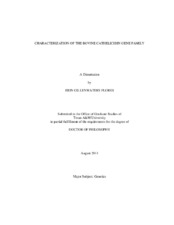| dc.description.abstract | Cathelicidins (CATHLs) are small, cationic antimicrobial peptides that establish an early innate immune defense against infections in mammals. Beyond their wide spectrum of antimicrobial activity, these peptides play important roles in wound repair, chemotactic activity, and apoptosis. Thus, comprehensive characterizing of bovine CATHLs could potentially identify underlying inherited differences in innate immunity and disease resistance in cattle. The purpose of the present study was to verify the placement of the CATHL cluster at the distal end of bovine chromosome 22 (BTA22), identify any single nucleotide polymorphisms (SNPs) and insertion-deletion (indel) polymorphisms within the gene family, explore copy number variation, and investigate the functional impact any of these variants may have in overall bovine innate immunity.
A framework radiation hybrid map was constructed with 7 markers screened against the bovine 12,000 rad whole genome RH (12K WG-RH) panel, which when compared to the current genome assembly (Btau_4.0) confirmed current gene order. Comparative sequence analysis for 10 domestic cattle breeds representing both Bos taurus taurus and Bos taurus indicus revealed 60 SNPs, 7 of which were nonsynonymous, and 5 indel mutations. Data from array comparative genomic hybridization (aCGH) between four Angus and four Nelore animals showed a 2-fold increase in copy number of the CATHL4 locus, which was verified by quantitative PCR (qPCR) of genomic DNA. Nelore animals showed an approximate 2-fold increase in the CATHL4 gene. Subsequently, the expression of CATHL4 in Nelore neutrophils exhibited a range of 2- to 5-fold increases in CATHL4 gene expression. Finally, a colorimetric bactericidal assay was performed on the neutrophils of the same Angus and Nelore animals previously genotyped for copy number variations (CNVs). After in vitro challenges to Staphylococcus aureus, Salmonella typhimurium, Mannheimia haemolytica, and Pasteurella multocida, the killing capacity of Nelore neutrophils was approximately 20 percent greater than Angus neutrophils for M. haemolytica and 10 percent greater for P. multocida. Characterization of this antimicrobial gene family is central to developing a firm understanding regarding the effects CATHL variation has with respect to bovine innate immunity. | en |


